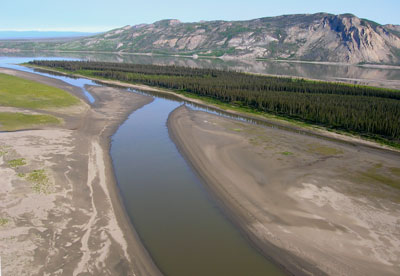My father-in-law picked up the phone when I called home to my wife from the Mackenzie Hotel in Norman Wells. "What does it look like?" he asked before handing the phone over to my wife. Trying to give him a sense of the immensity of this land in a sound bite I replied, "Imagine a river on the scale of the Mississippi--a huge river--but with massive mountains on either side and millions of acres of forests and lakes."
 |
Norman Wells is named for the natural oil and gas seepages that the explorer Mackenzie found on his way through and that were known to the aboriginal peoples that had always been here. The town sits on the edge of the Mackenzie with industrial oil complexs fringing the northern edge of town. In the river are a number of manmade islands that serve as locations for drilling operations and well pumps. There may be hundreds of wells scattered around Norman Wells.
We arrived on a Wednesday evening from Willow Lake and clouds were building. A flock of Common Redpolls descended into a patch of willows, alders, and birch near the airport while we waited. Flocks of scaup huddled on the lake.
Later, Richard Popko, a wildlife biologist who makes his home in Norman Wells, took me out to see the sites and we ended up at the sewage treatment lagoons in the evening where there were throngs of ducks. Lots of Mallards and some American Wigeon, Northern Shovelers, Green-winged Teal, Ring-necked Ducks, and Lesser Scaup. A beat-up looking Horned Grebe was still feeding a zebra-striped young.

